Transit-Oriented Development and Sustainable Cities: A Visual Analysis of the Literature Based on CiteSpace and VOSviewer
Abstract
1. Introduction
2. Concept and Application of TOD
3. Data Sources and Methods
3.1. Data Sources
3.2. Methods
4. Results of the Knowledge Mapping Analysis
4.1. Distribution of Countries and Research Institutions
4.2. Distribution of Theme and Domain Co-Occurrence
4.3. Cited Journal Co-Occurrence
4.4. Distribution of Co-Citations
4.5. Knowledge Cluster in TOD Research
5. Discussion
6. Conclusions
Author Contributions
Funding
Institutional Review Board Statement
Informed Consent Statement
Data Availability Statement
Acknowledgments
Conflicts of Interest
References
- Banister, D. Unsustainable Transport: City Transport in the New Century; Routledge: London, UK, 2005. [Google Scholar]
- Webster, J.; Watson, R. Analyzing the past to prepare for the future: Writing a literature review. MISQ 2002, 26, 13–23. [Google Scholar]
- Ibraeva, A.; Correia, G.; Antunes, A. Transit-oriented development: A review of research achievements and challenges. Transp. Res. Part A Policy Pract. 2020, 132, 110–130. [Google Scholar] [CrossRef]
- Jamme, H.; Rodriguez, J.; Bahl, D.; Banerjee, T. Twenty-Five-Year Biography of the TOD Concept: From Design to Policy, Planning, and Implementation. J. Plan. Educ. Res. 2019, 39, 409–428. [Google Scholar] [CrossRef]
- Deng, Y.; Chang, J.; Zhuo, X. A Summary on TOD Research at Home and Abroad During Recent Two Decades—An Analysis Based on the Visual Analysis into Citespace Software. Mod. Urban Res. 2019, 2, 94–100. [Google Scholar]
- Wu, T.; Li, M. International research progress and trend of transit-oriented development: An analysis of knowledge mapping based on cite space. Front. Environ. Sci. 2022, 10, 1251. [Google Scholar] [CrossRef]
- Kelbaugh, D. The Pedestrian Pocket Book: A New Suburban Design Strategy; Princeton Architectural Press: New York, NY, USA, 1989. [Google Scholar]
- Calthorpe, P. The Next American Metropolis: Ecology, Community, and the American Dream; Princeton Architectural Press: New York, NY, USA, 1993. [Google Scholar]
- Still, T. Transit-Oriented Development: Reshaping America’s Metropolitan Landscape; Transportation Research Board: Washington, DC, USA, 2002; pp. 44–47. [Google Scholar]
- Cervero, R.; Kockelman, K. Travel demand and the 3Ds: Density, diversity, and design. Transp. Res. Part D Transp. Environ. 1997, 2, 199–219. [Google Scholar] [CrossRef]
- Hess, D.; Lombardi, P. Policy Support for and Barriers to Transit-Oriented Development in the Inner City: Literature Review. Transp. Res. Rec. J. Transp. Res. Board 2004, 1887, 26–33. [Google Scholar] [CrossRef]
- Park, Y.; Huang, S.K.; Newman, G.D. A Statistical Meta-Analysis of the Design Components of New Urbanism on Housing Prices. J. Plan. Lit. 2016, 31, 435–451. [Google Scholar] [CrossRef]
- Chava, J.; Newman, P. Stakeholder Deliberation on Developing Affordable Housing Strategies: Towards Inclusive and Sustainable Transit-Oriented Developments. Sustainability 2017, 8, 1024. [Google Scholar] [CrossRef]
- Bertolini, L. Spatial development patterns and public transport: The application of an analytical model in the Netherlands. Plan. Pract. Res. 1999, 14, 199–210. [Google Scholar] [CrossRef]
- Vale, D.S. Transit-oriented development, integration of land use and transport, and pedestrian accessibility: Combining node-place model with pedestrian shed ratio to evaluate and classify station areas in Lisbon. J. Transp. Geogr. 2015, 45, 70–80. [Google Scholar] [CrossRef]
- Lyu, G.; Bertolini, L.; Pfeffer, K. Developing a TOD typology for Beijing metro station areas. J. Transp. Geogr. 2016, 55, 40–50. [Google Scholar] [CrossRef]
- Huang, R.; Grigolon, A.; Madureira, M.; Brussel, M. Measuring transit-oriented development (TOD) network complementarity based on TOD node typology. J. Transp. Land Use 2018, 11, 304–324. [Google Scholar] [CrossRef]
- Higgins, C.D.; Kanaroglou, P.S. A latent class method for classifying and evaluating the performance of station areas transit-oriented development in the Toronto region. J. Transp. Geogr. 2016, 52, 61–72. [Google Scholar] [CrossRef]
- Singh, Y.J.; Fard, P.; Zuidgeest, M.; Brussel, M.; Maarseveen, M. Measuring transit oriented development: A spatial multi criteria assessment approach for the city region Arnhem and Nijmegen. J. Transp. Geogr. 2014, 35, 130–143. [Google Scholar] [CrossRef]
- Guo, J.; Nakamura, F.; Li, Q.; Zhou, Y. Efficiency Assessment of Transit-Oriented Development by Data Envelopment Analysis: Case Study on the Den-en Toshi Line in Japan. J. Adv. Transp. 2018, 2018, 6701484. [Google Scholar] [CrossRef]
- Speel, P.H.; Shadbolt, N.; DeVries, W.; VanDam, P.H.; O’hara, K. Knowledge Mapping for industrial purpose. In Proceedings of the Twelfth Workshop on Knowledge Acquisition, Modelling Management (KAW′99), Banff, AB, Canada, 16–21 October 1999. [Google Scholar]
- van Eck, N.; Waltman, L. Software survey: VOSviewer, a computer program for bibliometric mapping. Scientometrics 2010, 84, 523–538. [Google Scholar] [CrossRef]
- Chen, C.; Ibekwe-SanJuan, F.; Hou, J. The Structure and Dynamics of Co-Citation Clusters: A Multiple-Perspective Co-Citation Analysis. J. Am. Soc. Inf. Sci. Technol. 2010, 61, 1386–1409. [Google Scholar] [CrossRef]
- Chen, Y.; Chen, C.; Liu, Z. The Methodology Function of Mapping Knowledge Domains—By reading 555 “CiteSpace” Papers. Stud. Sci. Sci. 2015, 33, 242–253. [Google Scholar]
- Li, X.; Ma, E.; Qu, H. Knowledge mapping of hospitality research—A visual analysis using CiteSpace. Int. J. Hosp. Manag. 2017, 60, 77–93. [Google Scholar] [CrossRef]
- Cervero, R. Transit-Oriented Development in the United States: Experiences, Challenges, and Prospects; Transportation Research Board: Washington, DC, USA, 2004. [Google Scholar]
- Dittmar, H.; Ohland, G. The New Transit Town: Best Practices in Transit-Oriented Development; Island Press: Washington, DC, USA, 2004. [Google Scholar]
- Jacobson, J.; Forsyth, A. Seven American TODs: Good practices for urban design in Transit-Oriented Development projects. J. Transp. Land Use 2008, 1, 51–88. [Google Scholar] [CrossRef]
- Bertolini, L.; Curtis, C.; Renne, J. Railway Station Mega-Projects and the Re-Making of Inner Cities. Built Environ. 2012, 38, 31–50. [Google Scholar] [CrossRef]
- Staricco, L.; Vitale Brovarone, E. Promoting TOD through regional planning. A comparative analysis of two European approaches. J. Transp. Geogr. 2018, 66, 45–52. [Google Scholar]
- Sung, H.; Oh, J. Transit-oriented development in a high-density city: Identifying its association with transit ridership in Seoul, Korea. Cities 2011, 28, 70–82. [Google Scholar] [CrossRef]
- Aoki, T.; Kadono, Y. Spatial Autocorrelation Analysis on The Movement to around Suburban Railway Stations by Generation. J. Archit. Plan. Trans. AIJ 2020, 85, 1695–1704. [Google Scholar] [CrossRef]
- Aoki, T. The Possibility of Reorganising Transit-oriented Development. Int. Rev. Spat. Plan. Sustain. Dev. 2022, 10, 55–78. [Google Scholar]
- Yang, Z.Z.; Li, D.Z. Study on TOD and its application in China. Urban Transp. China 2004, 2, 15–18. [Google Scholar]
- Erli, M. TOD Best Practice: Lesson Learned for GHG Mitigation on Transportation Sector in Surabaya City, Indonesia. Procedia-Soc. Behav. Sci. 2014, 135, 152–158. [Google Scholar]
- Chen, C. Science mapping: A systematic review of the literature. J. Data Inf. Sci. 2017, 2, 1–40. [Google Scholar] [CrossRef]
- Zhou, J.; Wang, Q.; Liu, H. Evaluating transit-served areas with non-traditional data: An exploratory study of Shenzhen, China. J. Transp. Land Use 2018, 11, 1323–1349. [Google Scholar] [CrossRef]
- Kamruzzaman, M.; Baker, D.; Washington, S.; Turrell, G. Determinants of residential dissonance: Implications for transit-oriented development in Brisbane. Int. J. Sustain. Transp. 2016, 10, 960–974. [Google Scholar] [CrossRef]
- Ding, C.; Cao, X.; Yu, B.; Ju, Y. Non-linear associations between zonal built environment attributes and transit commuting mode choice accounting for spatial heterogeneity. Transp. Res. Part A-Policy Pract. 2021, 148, 22–35. [Google Scholar] [CrossRef]
- Govada, S.S.; Spruijt, W.; Rodgers, T. Introduction to Hong Kong’s Development. In Smart Economy in Smart Cities; Vinod Kumar, T.M., Ed.; Springer: Singapore, 2017; pp. 171–186. [Google Scholar]
- Kumar, P.P.; Sekhar, C.R.; Parida, M. Residential dissonance in TOD neighborhoods. J. Transp. Geogr. 2018, 72, 166–177. [Google Scholar] [CrossRef]
- Loo, B.P.Y.; Chen, C.; Chan, E.T.H. Rail-based transit-oriented development: Lessons from New York City and Hong Kong. Landsc. Urban Plan. 2010, 97, 202–212. [Google Scholar] [CrossRef]
- Huang, Y.; Parker, D.; Minaker, L. Identifying latent demand for transit-oriented development neighbourhoods: Evidence from a mid-sized urban area in Canada. J. Transp. Geogr. 2021, 90, 102940. [Google Scholar] [CrossRef]
- Loo, B.P.Y.; du Verle, F. Transit-oriented development in future cities: Towards a two-level sustainable mobility strategy. Int. J. Urban Sci. 2017, 21 (Suppl. S1), 54–67. [Google Scholar] [CrossRef]
- Kamruzzaman, M.; Washington, S.; Baker, D.; Turrell, G. Does residential dissonance affect residential mobility? Transp. Res. Rec. 2013, 2344, 59–67. [Google Scholar] [CrossRef]
- Hickman, R.; Hall, P. Moving the City East: Explorations into contextual public transport-orientated development. Plan. Pract. Res. 2008, 23, 323–339. [Google Scholar] [CrossRef]
- Dong, H. If you build rail transit in suburbs, will development come? J. Am. Plan. Assoc. 2016, 82, 316–326. [Google Scholar] [CrossRef]
- Huang, W.; Wey, W.M. Green Urbanism Embedded in TOD for Urban Built Environment Planning and Design. Sustainability 2019, 11, 5293. [Google Scholar] [CrossRef]
- Langlois, M.; Wasfi, R.A.; Ross, N.A.; El-Geneidy, A.M. Can transit-oriented developments help achieve the recommended weekly level of physical activity? J. Transp. Health 2016, 3, 181–190. [Google Scholar] [CrossRef]
- Park, K.; Choi, D.A.; Tian, G.; Ewing, R. Not Parking Lots but Parks: A Joint Association of Parks and Transit Stations with Travel Behavior. Int. J. Environ. Res. Public Health 2019, 16, 547. [Google Scholar] [CrossRef]
- Huang, R.; Moudon, A.V.; Zhou, C.; Stewart, O.T.; Saelens, B.E. Light rail leads to more walking around station areas. J. Transp. Health 2017, 6, 201–208. [Google Scholar] [CrossRef] [PubMed]
- Dong, H.W. Evaluating the impacts of transit-oriented developments (TODs) on household transportation expenditures in California. J. Transp. Geogr. 2021, 90, 102946. [Google Scholar] [CrossRef]
- Zhou, X.; Zolnik, E.J. Transit-Oriented Development and Household Transportation Costs Household-Level Analysis. Transp. Res. Rec. 2013, 2357, 86–94. [Google Scholar] [CrossRef]
- Lee, J.; Choi, K.; Leem, Y. Bicycle-based transit-oriented development as an alternative to overcome the criticisms of the conventional transit-oriented development. Int. J. Sustain. Transp. 2016, 10, 975–984. [Google Scholar] [CrossRef]
- Trujillo, C.; Long, T. Document co-citation analysis to enhance transdisciplinary research. Sci. Adv. 2018, 4, e1701130. [Google Scholar] [CrossRef]
- Higgins, C.D.; Kanaroglou, P.S. Forty years of modelling rapid transit’s land value uplift on North America: Moving beyond the tip of the iceberg. Transp. Rev. 2016, 36, 610–634. [Google Scholar] [CrossRef]
- Kamruzzaman, M.; Wood, L.; Hine, J.; Currie, G.; Giles-Corti, B.; Turrell, G. Patterns of social capital associated with transit oriented development. J. Transp. Geogr. 2014, 35, 144–155. [Google Scholar] [CrossRef]
- Papa, E.; Bertolini, L. Accessibility and transit-oriented development in european metropolitan areas. J. Transp. Geogr. 2015, 47, 70–83. [Google Scholar] [CrossRef]
- Ewing, R. Travel and the Built Environment: A Meta-Analysis. J. Am. Plan. Assoc. 2010, 76, 265–294. [Google Scholar] [CrossRef]
- Singh, Y.J.; Lukman, A.; Flacke, J.; Zuidgeest, M.H.P.; van Maarseveen, M.F.A.M. Measuring TOD around transit nodes: Towards TOD policy. Transp. Policy 2017, 56, 96–111. [Google Scholar] [CrossRef]
- Nasri, A.; Zhang, L. The analysis of transit-oriented development (TOD) in Washington, D.C. and Baltimore metropolitan areas. Transp. Policy 2014, 32, 172–179. [Google Scholar]
- Chatman, D.G. Does TOD Need the T? J. Am. Plan. Assoc. 2013, 79, 17–31. [Google Scholar] [CrossRef]
- Cervero, R.; Dai, D. BRT TOD: Leveraging transit oriented development with bus rapid transit investments. Transp. Policy 2014, 36, 127–138. [Google Scholar] [CrossRef]
- Lin, J.J.; Shin, T.Y. Does Transit-Oriented Development Affect Metro Ridership? Evidence from Taipei, Taiwan. Transp. Res. Rec. 2008, 2063, 149–158. [Google Scholar] [CrossRef]
- Kim, S.; Ulfarsson, G.F.; Hennessy, J.T. Analysis of light rail rider travel behavior: Impacts of individual, built environment, and crime characteristics on transit access. Transp. Res. Part A-Policy Pract. 2007, 41, 511–522. [Google Scholar] [CrossRef]
- Dill, J. Transit Use at Transit-Oriented Developments in Portland, Oregon, Area. Transp. Res. Rec. 2008, 2063, 159–167. [Google Scholar] [CrossRef]
- Shao, Q.F.; Zhang, W.J.; Cao, X.Y.; Yang, J.W.; Yin, J. Threshold and moderating effects of land use on metro ridership in Shenzhen: Implications for TOD planning. J. Transp. Geogr. 2020, 89, 102878. [Google Scholar] [CrossRef]
- Liu, J.M.; Hou, X.H.; Xia, C.Y.; Kang, X.; Zhou, Y.J. Examining the Spatial Coordination between Metrorail Accessibility and Urban Spatial Form in the Context of Big Data. Land 2021, 10, 580. [Google Scholar] [CrossRef]
- Dou, M.X.; Wang, Y.D.; Dong, S.A. Integrating Network Centrality and Node-Place Model to Evaluate and Classify Station Areas in Shanghai. Isprs Int. J. Geo-Inf. 2021, 10, 414. [Google Scholar] [CrossRef]
- Yang, J.W.; Quan, J.G.; An, B.; He, C.F. Urban rail investment and transit-oriented development in Beijing: Can it reach a higher potential? Transp. Res. Part A-Policy Pract. 2016, 89, 140–150. [Google Scholar] [CrossRef]
- Yong, J.; Zheng, L.; Mao, X.; Tang, X.; Gao, A.; Liu, W. Mining metro commuting mobility patterns using massive smart card data. Phys. A-Stat. Mech. Appl. 2021, 584, 126351. [Google Scholar] [CrossRef]
- Ruan, Z.; Feng, X.; Wu, F.; Ding, C.; Hua, W. Land Use and Transport Integration Modeling with Immune Genetic Optimization for Urban Transit-Oriented Development. J. Urban Plan. Dev. 2021, 147, 04020063. [Google Scholar] [CrossRef]
- Charney, I. Re-planning an edge city: Tysons in the post-suburban era. Cities 2020, 106, 102919. [Google Scholar] [CrossRef]
- Cervero, R.; Day, J. Suburbanization and transit-oriented development in China. Transp. Policy 2008, 15, 315–323. [Google Scholar] [CrossRef]
- Laham, M.L.; Noland, R.B. Nonwork trips associated with transit-oriented development. Transp. Res. Rec. J. Transp. Res. Board 2017, 2606, 46–53. [Google Scholar] [CrossRef]
- Rayle, l. Investigating the Connection between Transit-Oriented Development and Displacement: Four Hypotheses. Hous. Policy Debate 2015, 25, 531–548. [Google Scholar] [CrossRef]
- Derakhti, L.; Baeten, G. Contradictions of Transit-Oriented Development in Low-Income Neighborhoods: The Case Study of Rosengard in Malmo, Sweden. Urban Sci. 2020, 4, 20. [Google Scholar] [CrossRef]
- Forouhar, A. Rail transit station and neighbourhood change: A mixed-method analysis with respect to neighbourhood context. J. Transp. Geogr. 2022, 102, 103389. [Google Scholar] [CrossRef]
- Maulat, J.; Krauss, A. Using contrats d’axe to coordinate regional rail transport, stations and urban development: From concept to practice. Town Plann. Rev. 2014, 85, 287–311. [Google Scholar] [CrossRef]
- Conesa, A. The accessibility assessment and the regional range of transitoriented development: An application of schedule accessibility measures in the Nord Pas-de-Calais region. J. Transp. Land Use 2018, 11, 119–141. [Google Scholar] [CrossRef]
- Staricco, L.; Brovarone, E.V. Implementing TOD around suburban and rural stations: An exploration of spatial potentialities and constraints. Urban Res. Pract. 2020, 13, 276–299. [Google Scholar] [CrossRef]
- Schwanen, T.; Mokhtarian, P.L. What if you live in the wrong neighborhood? The impact of residential neighborhood type dissonance on distance traveled. Transp. Res. Part D Transp. Environ. 2005, 10, 127–151. [Google Scholar] [CrossRef]
- De Vos, J.; Derudder, B.; Van Acker, V.; Witlox, F. Reducing car use: Changing attitudes or relocating? The influence of residential dissonance on travel behavior. J. Transp. Geogr. 2012, 22, 1–9. [Google Scholar] [CrossRef]
- Levine, J.; Inam, A.; Torng, G. A Choice-Based Rationale for Land Use and Transportation Alternatives: Evidence from Boston and Atlanta. J. Plan. Educ. Res. 2005, 24, 317–330. [Google Scholar] [CrossRef]
- Kamruzzaman, M.; Baker, D.; Turrell, G. Do dissonants in transit oriented development adjust commuting travel behaviour? Eur. J. Transp. Infrastruct. Res. 2015, 15, 66–77. [Google Scholar]
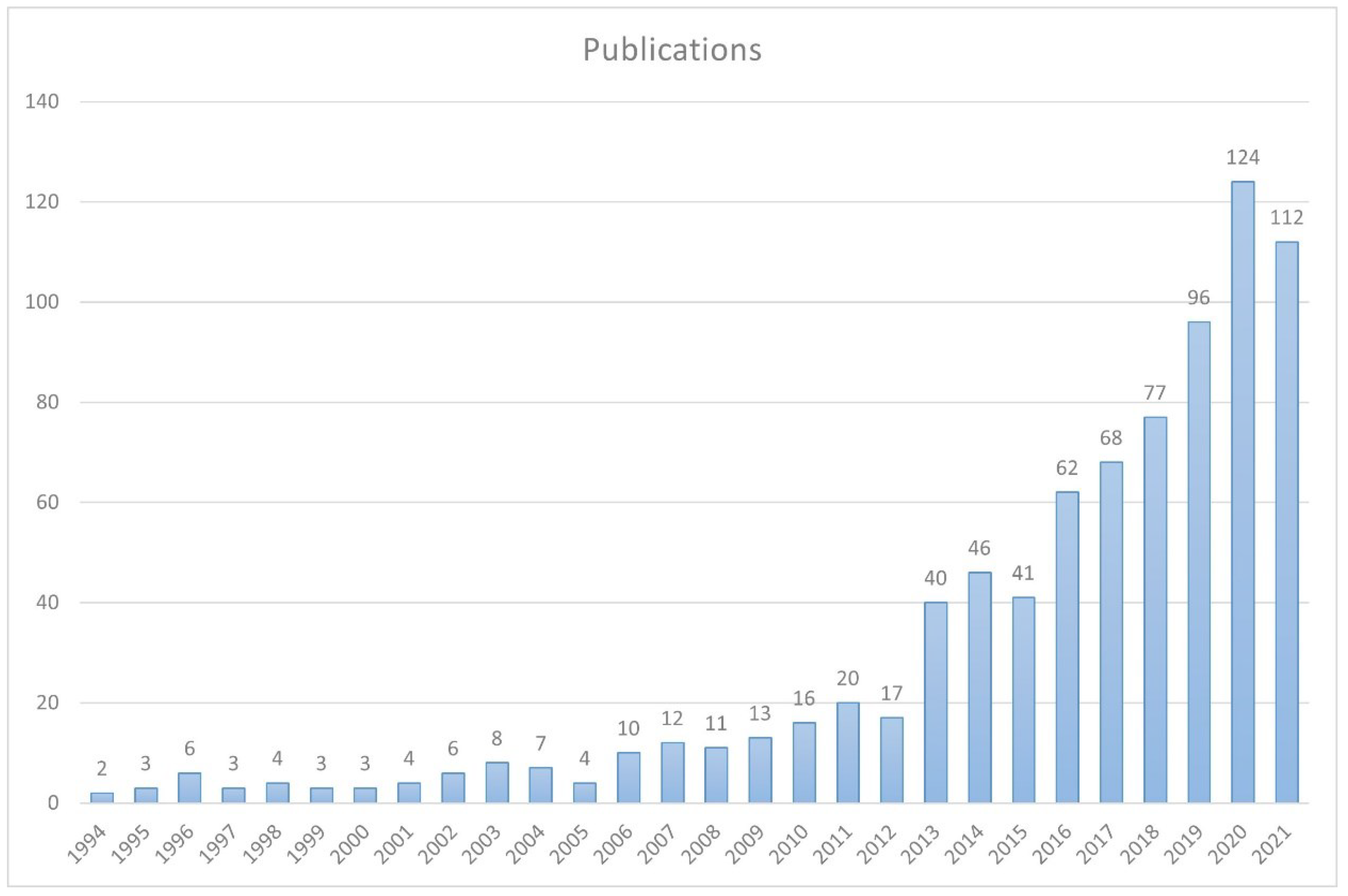


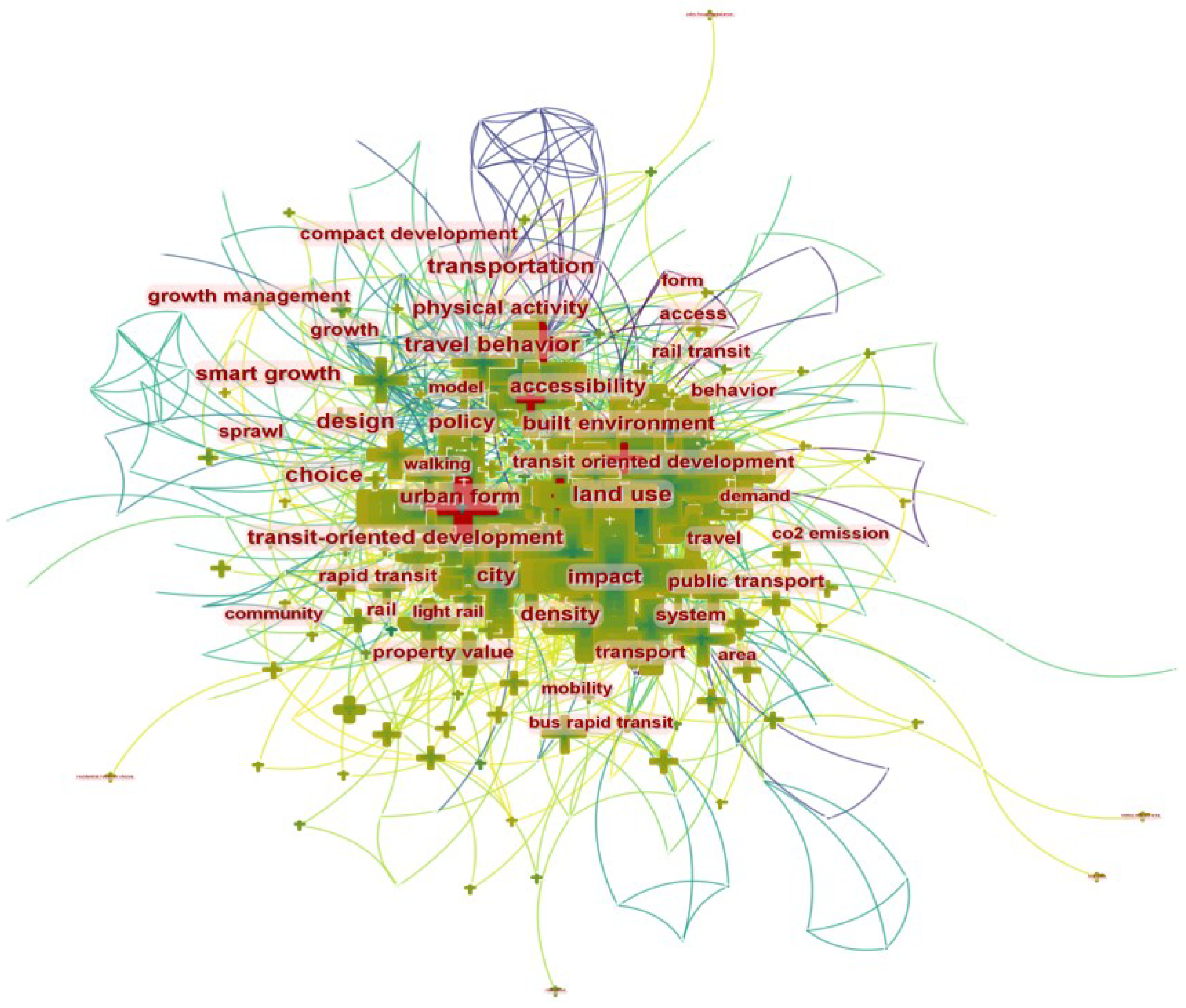


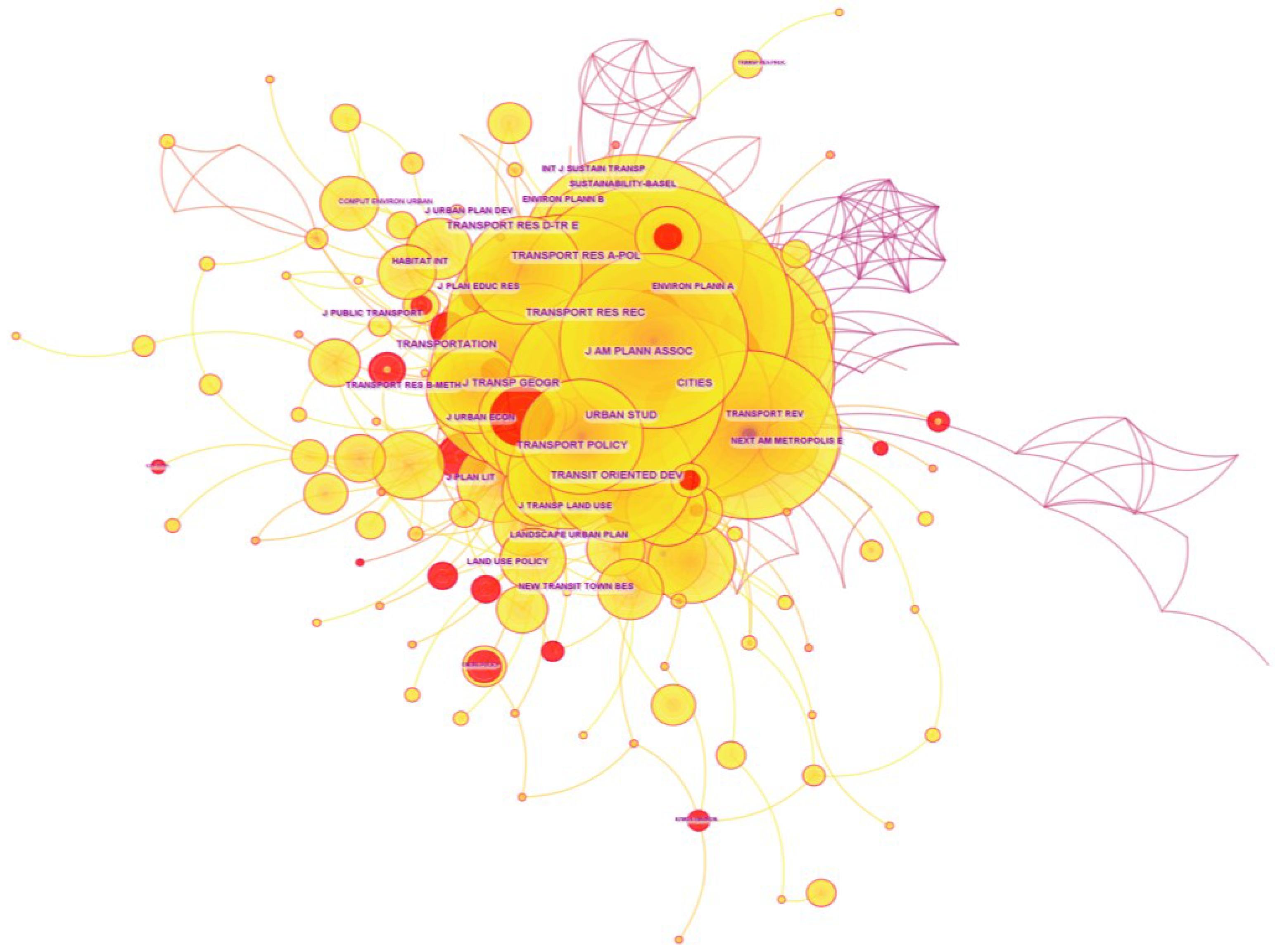
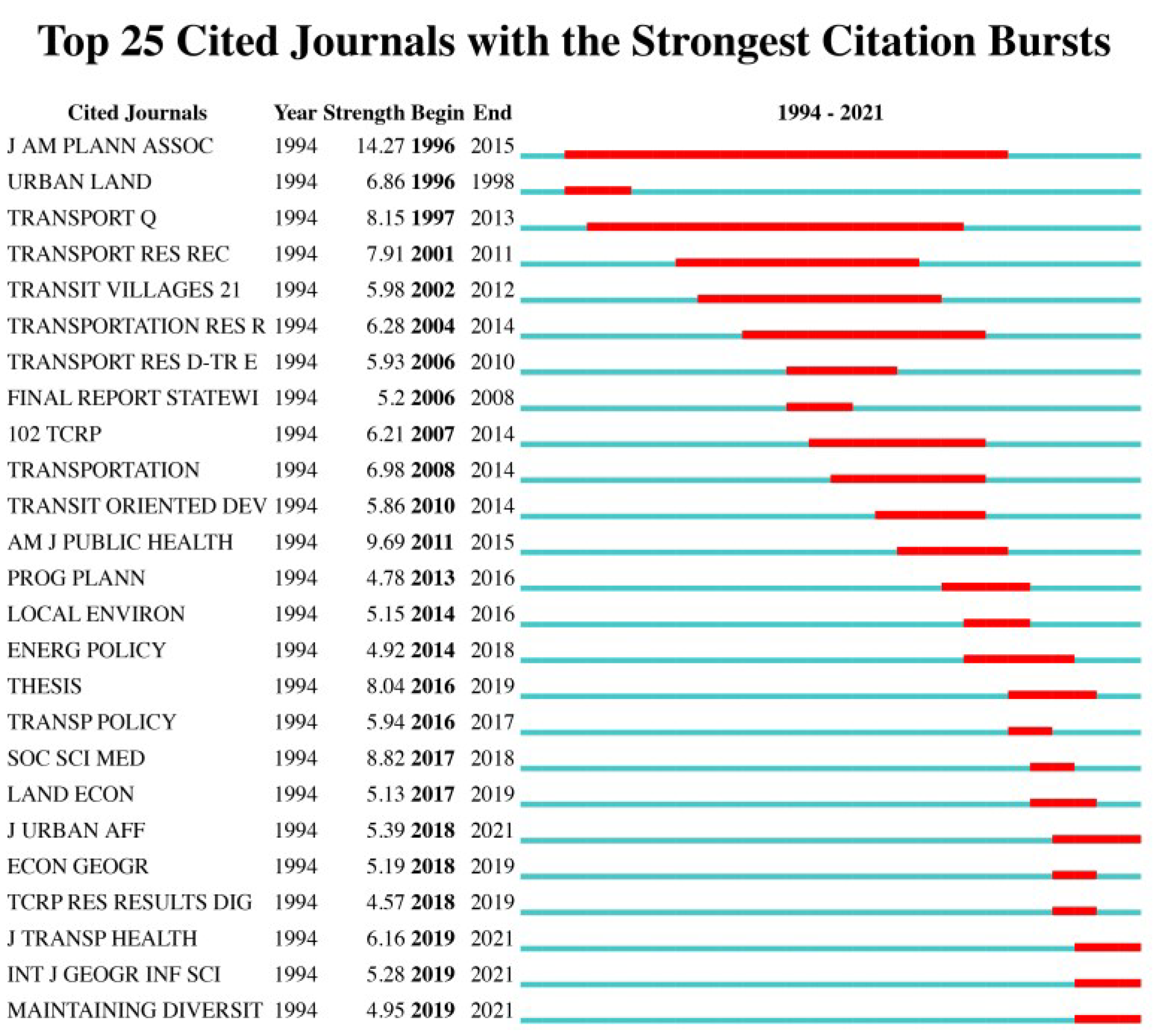
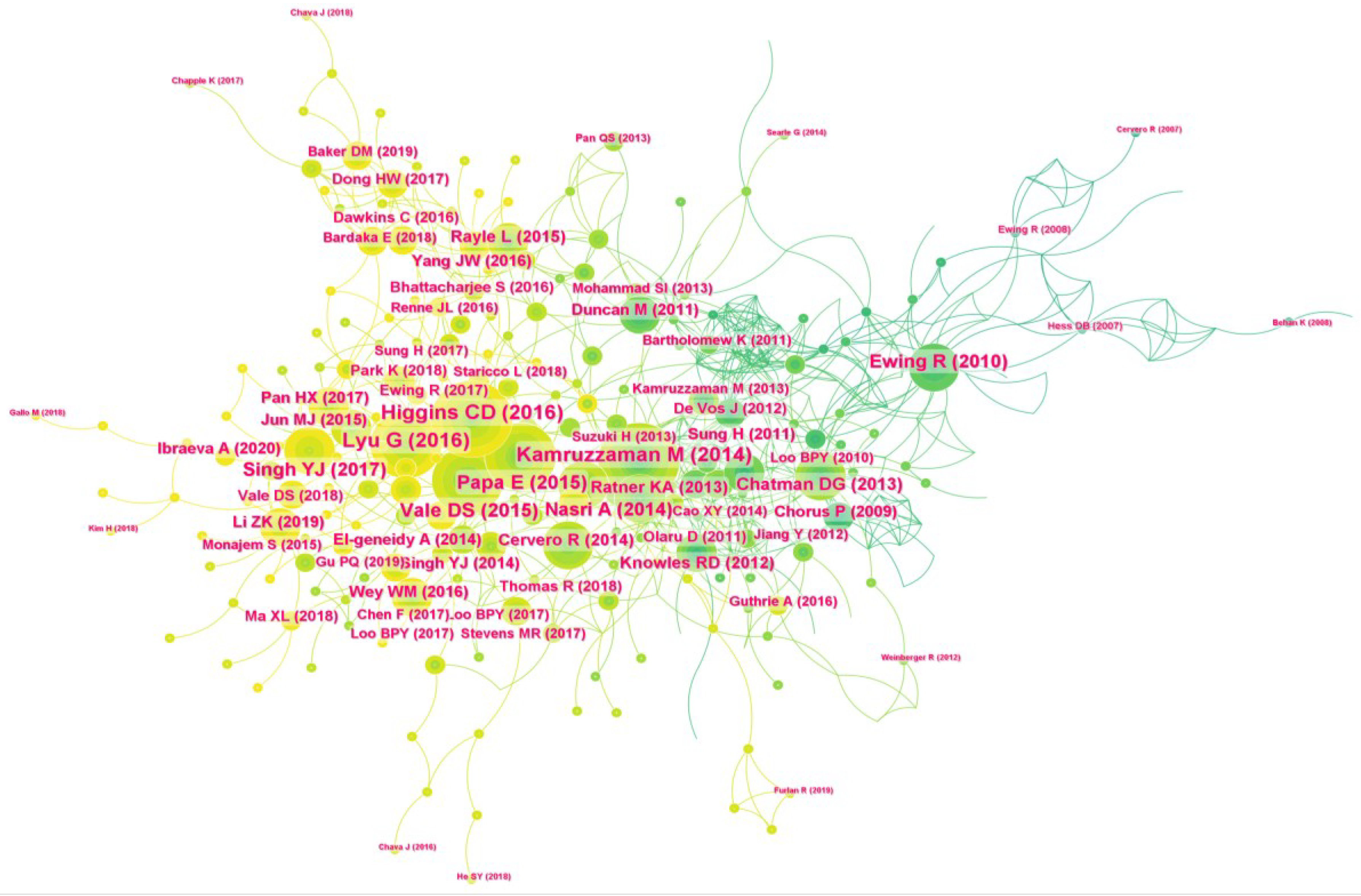


| Keywords | Methodology | Research Content |
|---|---|---|
| Neighborhood | Descriptive statistical analysis; cluster analysis; multinomial logit model; latent class analysis; strategies; questionnaire; regression model | Behavioral attitudes of commuters [41,42]; Residential location choices [43]; Station-neighborhood integration [44]; Residential dissonance [45] |
| Urban form | Descriptive statistical analysis; spatial analysis; OLS regression model analysis; fuzzy analytic network process | Enhancing urban form potential [46]; Supply of developable land [47]; Design of built environment [48] |
| Physical activity | Descriptive statistical analysis; statistical model; multinomial logistic regression | Describing travel behavior of residents [49]; Mobility choice [50]; Changes in walking [51] |
| Transportation | Descriptive statistical analysis; regression model; data envelopment analysis | Household expenditures on transportation [52,53]; smart growth [20]; Alternative modes of public transportation [54] |
| Year | Cited References | Count | Cluster ID |
|---|---|---|---|
| 2016 | Lyu G, J TRANSP GEOGR, 55, 40 [16] | 44 | 0 |
| 2016 | Higgins CD, J TRANSP GEOGR, 52, 61 [56] | 44 | 0 |
| 2014 | Kamruzzaman M, J TRANSP GEOGR, 34, 54 [57] | 43 | 2 |
| 2015 | Papa E, J TRANSP GEOGR, 47, 70 [58] | 40 | 0 |
| 2015 | Vale DS, J TRANSP GEOGR, 45, 70 [15] | 38 | 0 |
| 2010 | Ewing R, J AM PLANN ASSOC, 76, 265 [59] | 30 | 3 |
| 2017 | Singh YJ, TRANSPORT POLICY, 56, 96 [60] | 29 | 0 |
| 2014 | Nasri A, TRANSPORT POLICY, 32, 172 [61] | 28 | 0 |
| 2013 | Chatman DG, J AM PLANN ASSOC, 79, 17 [62] | 27 | 11 |
| 2014 | Cervero R, TRANSPORT POLICY, 36, 127 [63] | 21 | 0 |
| Cluster ID | Size | Silhouette | Theme | Average Year |
|---|---|---|---|---|
| 0 | 87 | 0.922 | Metro station area | 2019 |
| 1 | 65 | 0.926 | Neighborhood change | 2018 |
| 2 | 59 | 0.791 | European metropolitan area | 2015 |
| 3 | 51 | 0.932 | San Diego | 2012 |
| 4 | 33 | 0.966 | Residential dissonance | 2013 |
| 5 | 30 | 0.919 | Environmental travel behavior | 2018 |
| 11 | 14 | 0.958 | Rail transit | 2013 |
Disclaimer/Publisher’s Note: The statements, opinions and data contained in all publications are solely those of the individual author(s) and contributor(s) and not of MDPI and/or the editor(s). MDPI and/or the editor(s) disclaim responsibility for any injury to people or property resulting from any ideas, methods, instructions or products referred to in the content. |
© 2023 by the authors. Licensee MDPI, Basel, Switzerland. This article is an open access article distributed under the terms and conditions of the Creative Commons Attribution (CC BY) license (https://creativecommons.org/licenses/by/4.0/).
Share and Cite
Fang, Q.; Inoue, T.; Li, D.; Liu, Q.; Ma, J. Transit-Oriented Development and Sustainable Cities: A Visual Analysis of the Literature Based on CiteSpace and VOSviewer. Sustainability 2023, 15, 8223. https://doi.org/10.3390/su15108223
Fang Q, Inoue T, Li D, Liu Q, Ma J. Transit-Oriented Development and Sustainable Cities: A Visual Analysis of the Literature Based on CiteSpace and VOSviewer. Sustainability. 2023; 15(10):8223. https://doi.org/10.3390/su15108223
Chicago/Turabian StyleFang, Qiaoling, Tomo Inoue, Dongqi Li, Qiang Liu, and Jian Ma. 2023. "Transit-Oriented Development and Sustainable Cities: A Visual Analysis of the Literature Based on CiteSpace and VOSviewer" Sustainability 15, no. 10: 8223. https://doi.org/10.3390/su15108223
APA StyleFang, Q., Inoue, T., Li, D., Liu, Q., & Ma, J. (2023). Transit-Oriented Development and Sustainable Cities: A Visual Analysis of the Literature Based on CiteSpace and VOSviewer. Sustainability, 15(10), 8223. https://doi.org/10.3390/su15108223






